Skip To Section
White horses are exceptionally rare, making them quite intriguing. If you have ever seen a white horse in person, you know just how incredible they are.
There are many gorgeous white horse breeds.
Let’s take a look.
1. American Cream Draft

The American Cream Draft Horse is authentically American, with its roots dating back to the early 20th century in Iowa.
This particular breed of horse also referred to as American Creams, is cream in color with light pink skin, a white mane, and amber eyes. The champagne gene is responsible for the horse’s physical traits.
American Creams average 15-16.3 hands tall at the withers. These horses have a medium to large build, with mares averaging 1,600 to 1,800 pounds and stallions reaching upwards of 2,000 pounds.
As the name suggests, the American Cream Draft is indeed a draft horse, originally built to work. Before the Machine Age changed the face of farming, this horse was a staple on the fields of the midwest.
This beautiful big white horse breed is the country’s only draft horse still in existence today. It’s incredibly rare, with the Livestock Conservancy declaring its population numbers to be critical.
The American Cream’s willingness to work and calm demeanor make them quite the asset on a farm. Luckily, American Cream’s numbers are growing.
2. Orlov Trotter
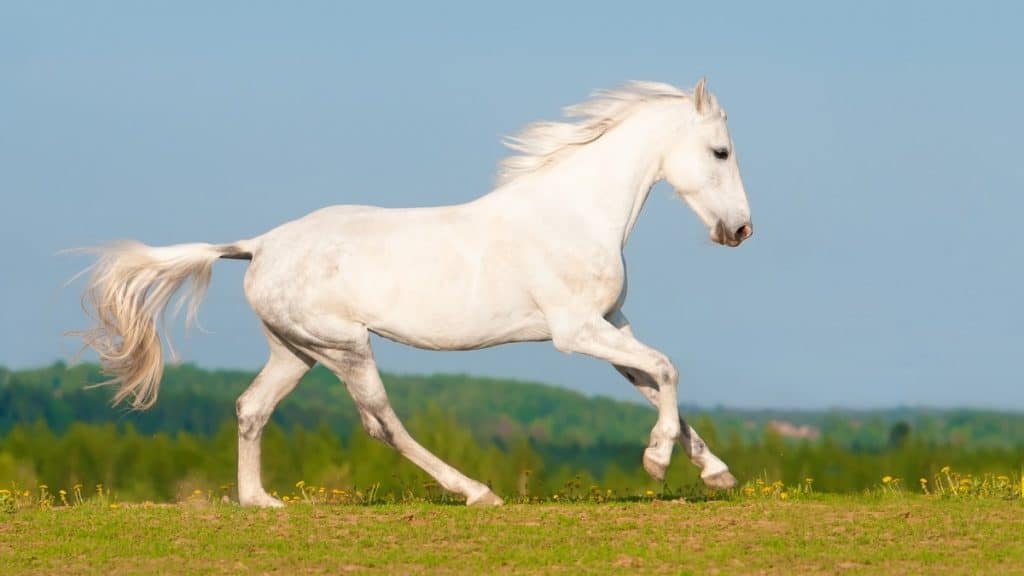
The Orlov Trotter, developed in the late 18th century in Russia, is a cross between Arabian stallions and European (mainly Danish, Dutch, English, and Mecklenburg) breeds. The famous Russian horse is known for its incredible speed, endurance, and beauty.
Orlov Trotters are typically 15-17 hands tall and weigh an average of 990 pounds.
Orlov trotters are hard-working and are often used for light to medium-heavy agricultural jobs. Orlovs are also used to improve other breeds of horses.
Russian nobility commonly used Orlov Trotters for riding and harness racing in the 19th century.
While Orlov trotters are known for their speed, American Standardbreds proved to be faster when harness racing became popular towards the end of the 19th century. This fierce competition led to the crossing of Standardbred stallions with Orlov mares, resulting in the Russian Trotter, a new breed.
Due to crossbreeding and the damaging effects of war, there was a distinct possibility that the Orlov Trotter would become extinct. However, the graceful, elegant Orlov trotter survived, and over a dozen farms in Ukraine and Russia raise Orlov Trotter thoroughbreds.
3. Shagya Arabian
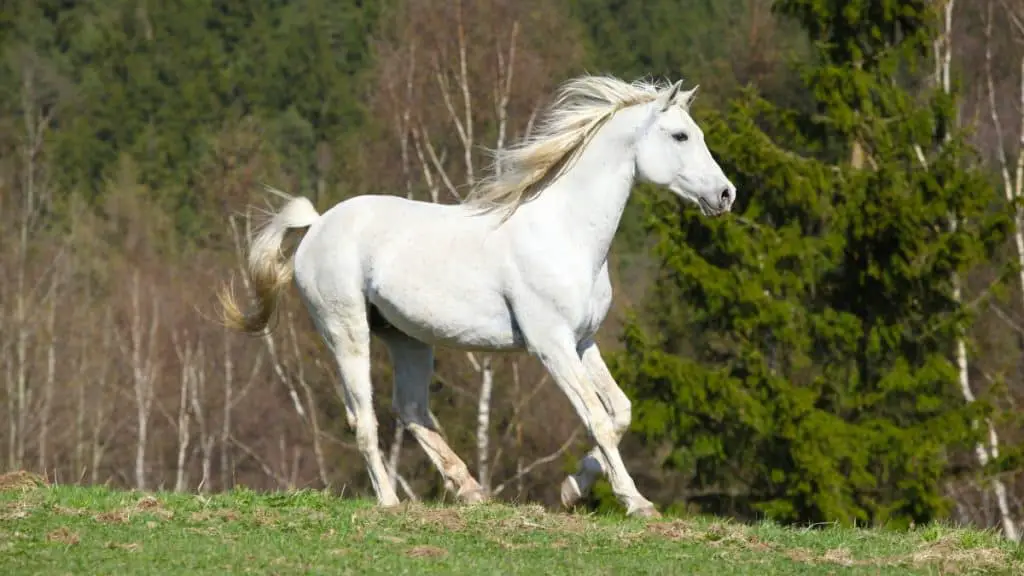
The Shagya Arabian horse breed originated in the Austro-Hungarian Empire in the 19th century. Today, the Shagya is commonly found in Austria, the Czech Republic, Germany, Poland, Hungary, and former Yugoslavian countries. You can also find the breed across the globe as it has been exported to other countries.
You can trace the bloodlines of a Shagya Arabian to the stud books of Rădăuți, Topolcianky, Babolna. In 1978, the World Arabian Horse Organization (WAHO) gave Shagya Arabians a special status: if a Shagyas was bred pure following the Babolna and Topolcianky system can be called “purebred Shagya Arabians.”
This special status means that the Shagya breeders are associate members within WAHO, so they can use the WAHO emblem. WAHO does clearly state, however, that Shagyas who were bred purely among themselves are not considered “purebred Arabian.”
Shagyas are 15-16 hands tall at withers and weigh approximately 1,000 pounds.
The Shagya Arabian is known for being highly alert, friendly, and intelligent. They are strong and tall – more so than a purebred Arabian horse due to breeding practices.
Shagyas have incredible stamina. The breed proved to be a hardy cavalry horse. Today it is commonly used for endurance riding, competitions, and shows.
4. Lipizzan Horse

The Lipizzan horse originated in Lipica, Slovenia, during the 16th century. The Lipizzan was named after the Lipizza Stud from the Habsburg monarchy.
The Lipizzan was originally bred to be gray as the Habsburg royal family preferred the color. However, the breed whitens over the years to a bright white. It can take 6-10 years before the horse becomes the white coloration that it is known for.
The Baroque-type breed has close ties with the Spanish Riding School of Vienna, Austria, where the horse is trained using the principles of classical dressage. These traditional training methods date back centuries and include stylized, highly controlled jumps.
As with other breeds, World War I and II took a toll on the Lipizzan’s numbers, leaving the breed endangered. American soldiers took notice and helped save the breed. Disney’s Miracle of the White Stallion highlights the rescue of the Lipizzan.
Modern Lipizzans’ bloodlines can be traced to the eight stallions that are considered the classic foundation bloodstock of the breed. The eight stallions were all foaled in the late 18th and early 19th centuries. Lipizzans are typically found in Europe.
Lipizzans generally mature to 14.2 to 16.1 hands in height and weigh 1,000 to 1,300 pounds.
The Lipizzan is a powerful horse known for its elegant beauty and exceptional riding. The breed matures slowly and is known for its longevity.
5. Camargue

The Camargue horse (Cavallo de Delta), considered one of the oldest breeds in the world, is indigenous to southern France’s marshlands, which is in the Camargue area.
This ancient breed has lived in the marshes and wetlands of the Camargue area for centuries. Living in harsh conditions allowed the breed to develop incredible endurance, agility, and resilience.
Camargues are known to be highly intelligent with an excellent temperament.
They are 13 to 14 hands in height, putting them on the smaller side compared to other breeds.
Once a Camargue reaches adulthood it will have turned white in color with a gorgeous white mane and tail.
6. Camarillo White Horse
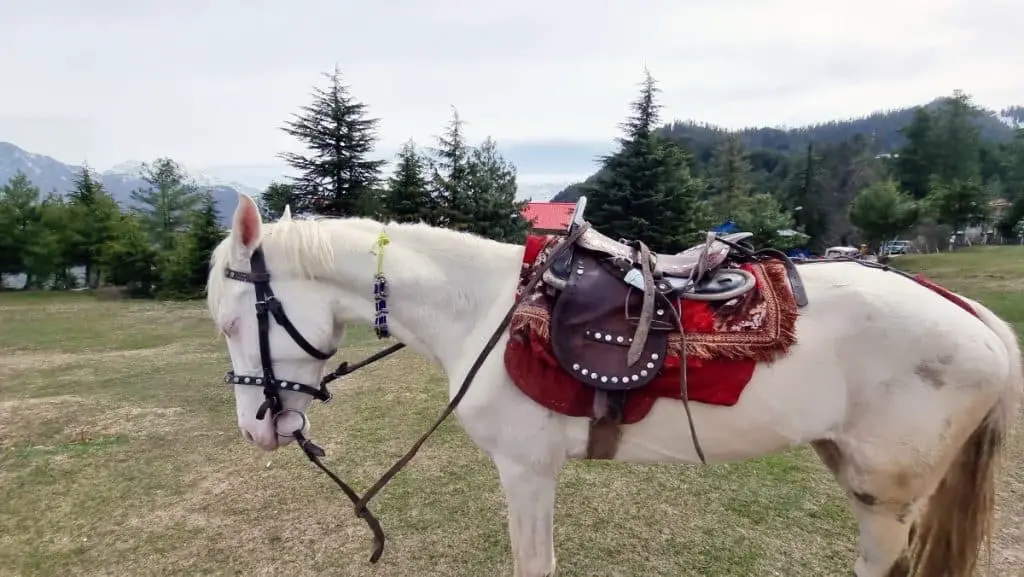
The Camarillo White Horse originated in Sacramento, California in 1921 (around 100 years old). During the California State Fair, a farmer named Adolfo Camarillo took notice of a 9-year-old stallion named Sultan. He purchased and bred Sultan, which resulted in a new breed, the Camarillo.
The Camarillo has pink skin and bright white fur. It has a muscular, compact build, although it is refined as well. It is 14.2-17 hands tall and weighs an average of 1,250 pounds.
This pure white horse breed is a popular parade choice due to its beautiful, majestic presence.
After Adolfo Camarillo’s death, the remaining horses were auctioned off and the breed became close to being extinct. Only 11 Camarillos remained in the late 1980s.
The Camarillo White Horse Association was established in 1992 to ensure the breed, which consisted of only 11 horses, did not die out.
7. Percheron
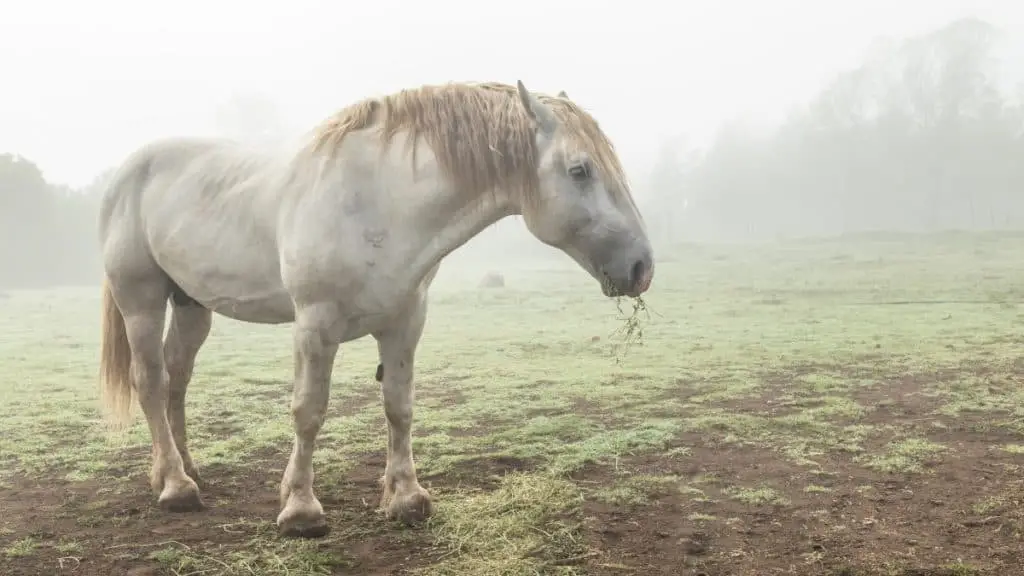
The Percheron is a draft horse with origins in Western France’s former Perche province. The breed has close ties to royalty.
The name Percheron means powerful, a suitable moniker as the breed was originally bred for war.
The first thoroughbred Percheron studbook was officially established in 1883 in France.
The horse is muscular and strong with a height ranging from 15 to 19 hands and an average weight of 1,900 pounds (United States Percherons). These numbers vary based on country.
While this breed is typically gray or black, it can also be a beautiful bright white. They are typically 16-17 hands at the withers and have an average weight of 2,000 pounds.
The horse eventually became a popular choice for pulling carriages and hauling agricultural goods.
The Percheron is a hard worker that’s incredibly intelligent and highly social.
8. White Quarter Horse
The White Quarter Horse, originating in the United States in the 1660s, is one of the country’s oldest recognized horse breeds. It is a cross between early English imported horses and Spanish horses.
White Quarter Horses are 14-16 hands tall at the withers and weigh between 950 and 1,200 pounds.
The White Quarter Horse quickly became a popular race and show horse. In fact, the horse’s name is a result of it beating out other horse breeds in races that are a quarter-mile or less. They are remarkably fast short sprinters, clocking speeds of up to 55 mph.
The breed is known to be exceptional ranch horses; they are versatile, hard workers. The horse is skilled in cutting, reining, barrel racing, and a host of other maneuvers, making them a showstopper at competitive western show events.
The American Quarter Horse is also popular in English disciplines, such as dressage, jumping, driving, and a variety of other equestrian activities.
Today, the American Quarter Horse tops the horse breed registry with nearly three million registered horses. It’s the most popular breed in America.
9. Andalusian White Horse
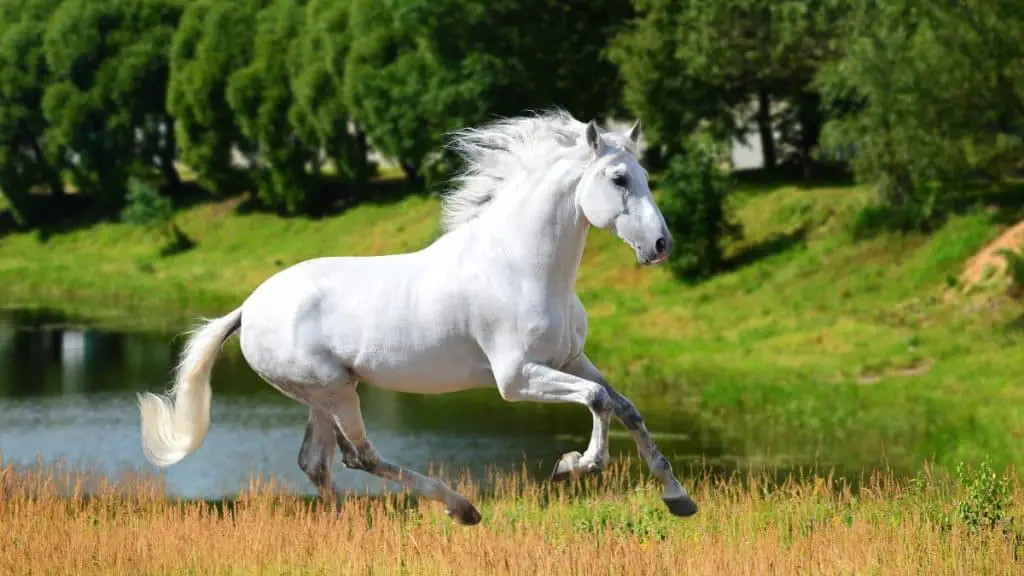
The Andalusian White Horse is a descendant of the horses that roamed the Iberian Peninsula for centuries. Its name is derived from the cave paintings found in the region. In the 15th century, the Andalusian became a recognized horse breed.
The Andalusian has been a prized warhorse, a favorite of nobility, and a tool of diplomacy for the Spanish government throughout its lengthy history.
Disease, war, and crossbreeding in the 19th century and into the 20th century caused a drastic drop in the breed’s numbers.
In fact, Spain restricted any exporting of Andalusians until the 1960s. After restrictions were lifted, Andalusians grew in numbers as other countries began breeding the horse.
The Andalusian is strong, with a stocky, compact build. They have thick manes, and flowing tails, and are typically bright gray or a light white. They are known to be docile, intelligent, and sensitive.
Andalusians are approximately 15 hands at the withers and weigh an average of 900 pounds.
The breed is commonly used for classical dressage and riding.
10. White Mustang Horse
White Mustang Horses are descendants of Spanish horses that can be found free-roaming in Montana, Idaho, and other western states in the US. The U.S. Bureau of Land Management (BLM) protects and maintains the land that mustangs free-roam.
Spanish mustangs are commonly referred to as wild horses. However, they are actually considered feral horses since their ancestors were domesticated at one point.
Mustangs can be adopted through government programs, where the owner can then train them.
While mustangs come in a wide range of colors, they can be bright white. They are 14-15 hands tall and weigh an average of 800 pounds.
11. Blazer Horse
The Blazer horse originated in the mid-20th century in the United States. The breed can be traced back to Little Blaze, a famous stallion from Wyoming with an impressive build and vibrant spirit.
Blazer horses are typically bright white. Their thick, long tail and height of 13-15 hands make them easily recognizable.
Idaho is home to many Blazer horses as it’s where the American Blazer Horse Association is headquartered, but they can be found across the United States.
The Blazer Horse is known to be a fantastic jumper, conquering exceptionally high heights. The horse is a skilled mountain climber. The breed is also used to crop and cut grass.
12. Boulonnais Horse
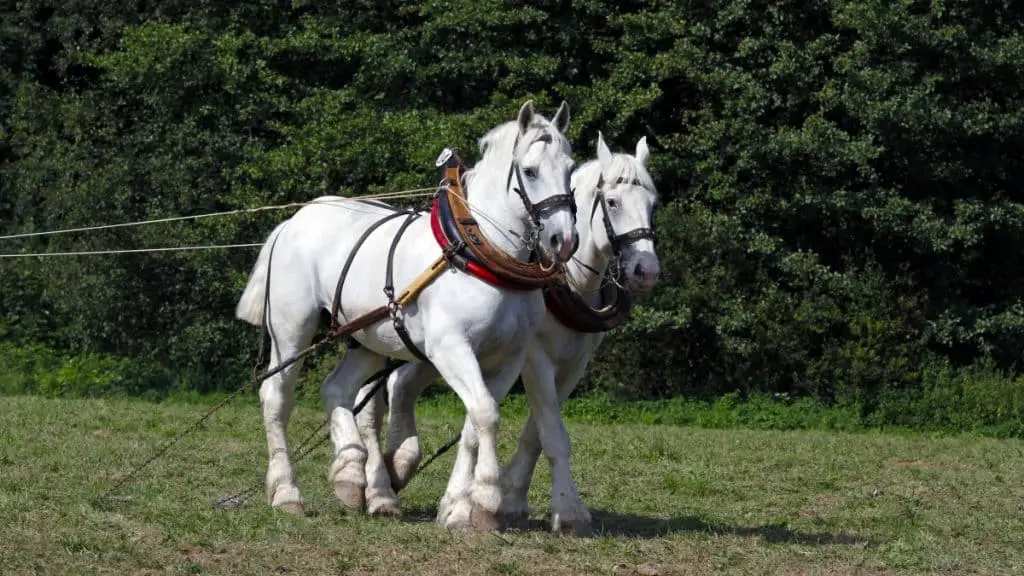
The Boulonnais horse is a distinguished French breed with a distinctive white marble coat. As a result, this equine is sometimes called a white marble horse.
They are sociable and lively and known for their smooth and lively gait. They’re popular for fieldwork, recreational riding, and pulling carriages because of their smooth and energetic gaits.
The average height of a typical modern Boulonnais horse is 15-16.3 hands and weighs around 1320 pounds.
White marble horses are generally gray in color, although they may appear white. In France, chestnut and black hues are permitted by breed registries.
FAQs
What Makes A Horse A Purely White Horse?
True white horses have pink, unpigmented skin with a white coat of hair. In addition, white horses tend to have dark eyes but can also be born with blue eyes.
Some white horses have partial pigmentation in their hair and skin at birth that eventually lightens. There is no longer any visible pigmentation. On the other hand, gray horses are born with pigmented skin that they will have all of their lives. So while a gray horse’s hair might lighten, its skin will remain pigmented.
This lack of pigmentation is known as depigmentation phenotypes caused by specific genes.
There are different types of white horses, including the following:
Dominant White Horses: Dominant white horses are all white horses with pink skin and brown eyes. Dominant white horses have a white nose that is prone to sunburn.
Sabino-White Horses: Sabino-white horses have nearly-white or all-white coats, pink skin, and dark eyes. DNA tests are typically the only way to tell a Sabino-white horse from a dominant white horse. As with dominant white horses, sabino whites are subject to sunburn.
Gray and Ivory Champagne horses appear white but are not classified as actual white horses.
It’s relatively simple to tell a gray horse from a white one; a gray horse will have black skin while the white horse will have pinkish, unpigmented skin.
Ivory Champagne horses have both champagne and cream dilution genes. You can visibly see that their skin is a semi-pigmented, rosy color. Their cream-colored coat can easily be mistaken for white.
Before we go any further, let’s take a closer look at what dilution means when talking about white horses.
A dilution gene is simply a gene that makes a horse’s hair lighter in color. There are several types of dilution genes:
Cream Gene (single-dilution): The cream gene creates colors, including cremello, smoky cream, and perlino.
Cream Gene (double-dilution): The cream gene also creates colors that include palomino, buckskin, and smoky black.
Dun Gene: the Dun gene is responsible for lightening a horse’s body but doesn’t have as much of an effect on its mane, ears, legs, or tail. Colors include dun, red dun, and grullo.
Champagne Gene: The champagne gene is rare; it produces cream coloring, freckled skin, and hazel eyes.
Pearl Gene: The pearl gene is recessive, and its effect depends on the number of allele copies present. One copy means there is no effect on a chestnut, bay, or black horse. Two copies on a chestnut horse create a light apricot color.
Silver Dapple Gene: The silver dapple gene lightens the horse’s mane and tail rather than the body.
White horses do not have any dilution genes. This is because they are genuinely white and quite rare.
It’s interesting to note that gray horses do not have dilution genes either but are not considered a true white horse, even if they appear white, due to their skin pigmentation.
Is There Such A Thing As An Albino Horse?
There is no such thing as an albino horse. No one has ever reported a case of a horse that had all of the characteristics that define an albino.
So, what is an albino, then? An albino typically has reddish eyes along with white skin and white hair. In addition, albinos have pigment cells, or melanocytes, while white horses lack any melanocytes.
While many may refer to white horses as albino, it’s not the case.
In Conclusion
The white horse is a truly majestic being that is ancient and magical.
White horses have different origins, some of them dating back centuries. Each breed has a unique story behind it, and we hope this guide provided you with valuable information about white horse breeds.
